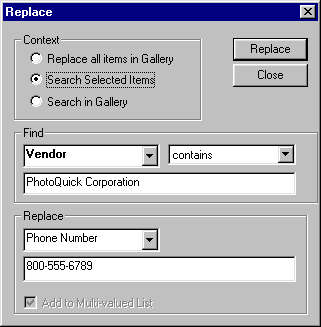You can easily replace keywords, descriptions, and Custom Field values for multiple items in a catalog at the same time using Portfolio’s powerful Replace function. For example, if you have defined a Custom Field for the print date for your images and the print date for some of those images slips by a week, you can replace the incorrect date in that field for all the affected images at once. You can even search on a different field than the field being replaced, and you can choose to search all the items in the active Gallery, or limit the search to only the selected items.
To Replace items based on field values:
Choose Replace... from the Catalog menu (or press Command+Option+R (Mac OS) or Ctrl+Shift+R (Windows).
The “Find and Replace” dialog box appears.
Select the Context of the search using the Context radio buttons.

Replace all Items in Gallery: Disables the Find and forces the Replace value into all records in the Gallery.
Search Selected Items: For the selected items, Replace the value for all records matching the search criteria.
Search Gallery: For all items in the Gallery, Replace the value for all records matching the search criteria.
Unselected records are not affected.
Enter the parameters of the Find by selecting the field to be searched and a search clause from the pop-ups, then enter the text string to search on.
Note: This step does not apply if you selected “Replace all Items in Gallery” in step 2.
Enter the parameters of the Replace by selecting a field to be replaced from the Replace Field pop-up, then enter the data string that will replace the existing data in the selected field.
If the field you selected is a Multi-valued field, indicate whether you want the Replace value added to the list of existing values, or to replace the value indicated in the Find value field.
Note: Exercise caution when you perform a Replace where the Find field is different than the Replace field and “Add to Multi-valued List” is unchecked, as the entire contents of the Replace field will be replaced.
Click “Replace.”
Item records matching the Find criteria will be located, and data in the indicated Replace field will be replaced.
Tip: You can populate Custom Fields based on information in existing fields. This can be handy when you want to add a new field based on existing information and/or move existing information into a different field. For example, you might search for every record that has a particular vendor name in the Description field and move that vendor’s name to a custom “Vendor Name” field. Then you might search all the records again using the Vendor Name, and add the vendor’s web address to a custom “Vendor Website” field.
Note: Because the “Replace” command in Portfolio is replacing field data in item records that are already being displayed, and is not (like the Portfolio “Find” command) searching for items to display, the “Replace” command has no effect on the Gallery (other than to show any field data that was replaced during the Replace operation).
Add to Multi-valued List Checkbox
The Multi-valued List option is only available when a Custom Field defined as a Multi-value List is selected in the Replace clause.
There are four possible options for replacing multi-valued fields. These are based on the type of search being conducted, and whether the “Add to Mult-valued List” checkbox is On (checked) or Off (unchecked). An example of each is given below. The first three options are fairly straight-forward. The fourth can be extremely powerful, but unless understood fully, may lead to unwanted results. If you are interested in applying the fourth scenario, you may want to experiment with a small, unwanted catalog until you fully understand the ramifications.
For the following, assume that you have a Multi-valued List with two items it: “cat” and “dog.”
Examples and Results:
Option 1: You want to search for all records containing “cat” and add the word “snake” to the list. To accomplish this, enter “cat” in the Find field, enter “snake” in the Replace field, and turn the “Add Multi-value” checkbox On. This results in a multi-value list containing “cat,” “dog” and “snake.”
Option 2: You want to search for all records with some commonality and add “snake” to the value list. To accomplish this, enter your search parameter in the Find field (such as a creation date or partial filename), enter “snake” in the Replace field, and turn the “Add Multi-value” checkbox On. This results in a multi-value list containing “cat,” “dog” and “snake.”
Option 3: You want to search for all records containing “cat” and replace the word “cat” with the word “snake.” To accomplish this, enter “cat” in the Find field, enter “snake” in the Replace field, and turn the “Add Multi-value” checkbox Off. This results in a multi-value list containing only “snake” and “dog.”
Option 4: You want to search for all records with some commonality and replace the entire value list with the word “snake.” To accomplish this, enter your search parameter in the Find field (such as a creation date or partial filename), enter “snake” in the Replace field, and turn the “Add Multi-value” checkbox Off. This results in a multi-value list containing only the word “snake.” This can be helpful when you want to replace the entire value list and start over again with new values. After replacing the list with a single value you can perform a regular Find to locate all the items with that value and add the other list items in the normal way.
See also:
Populating Fields in Multiple Records at the Same Time